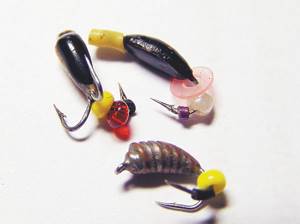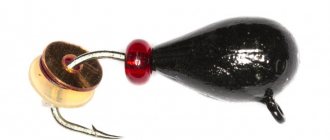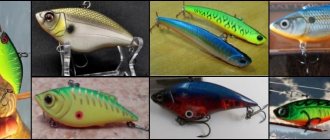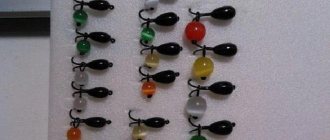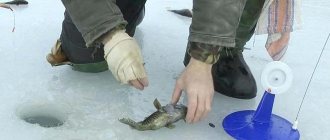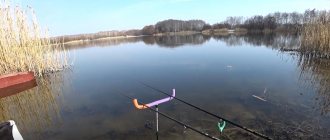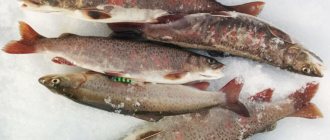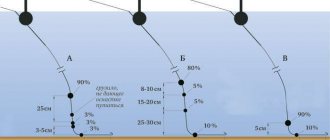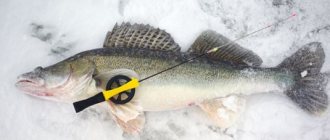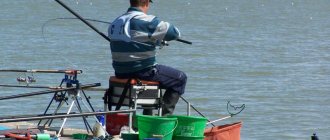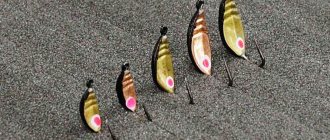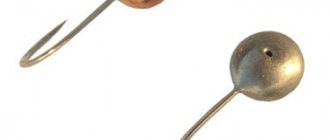Definition of goat jig
The goat jig, also called the “goat-dereza” and “kozochka” , is a jig for baitless fishing, equipped with two hooks.
This bait got its name because of its resemblance to the head of a domestic animal. The principle of operation of a goat jig is to imitate the movements of a small aquatic invertebrate or, when using large “goats”, a small fry.
Small goats
Small goats are usually used in pairs. Take one lead with decoration and one bare tungsten. Multi-colored beads are great as decoration.
The lead goat is often used for scouting . It catches fish more consistently than any other jig. That is why most often they start fishing with a small goat.
The tungsten goat is used in depths up to 3m and is an excellent choice for learning to play as a goat. But lead bait is always used as the main bait.
Options
Form
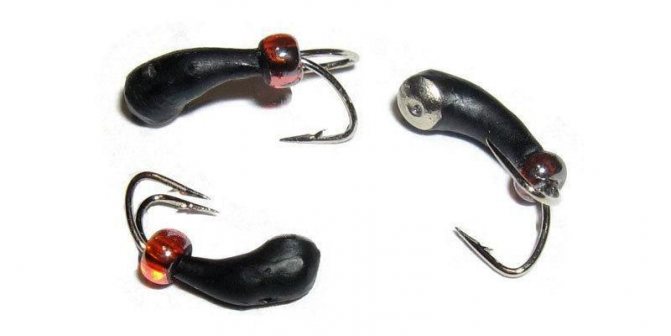
Although the general design of the goat jig is basic, there are nevertheless many modifications of this bait. Most often, “goats” resemble the well-known “Uralki” in shape. The bait can be elongated or shortened, straight or curved, and therefore the action of the jig changes. Different modifications are designed for different fishing conditions and for catching different types of fish.
Size
The length of goat lead jigs ranges from 8 to 12 mm, and the width rarely exceeds 3 mm. Naturally, tungsten jigs with a similar mass are smaller in size.
Material of manufacture
Most goat jigs are made from lead and tungsten. Soldered jigs have a crown made of non-ferrous metal (copper, brass, cupronickel) and a body made of solder. If jigs are made by winding wire around the shank of a hook, use tin or, for very light “goats,” copper wire.
Color
The most popular color of goat jigs is black . Black jigs are usually used with additional decorations. Catching baits are jigs with a crown made of non-ferrous metal without any additional elements. For certain reservoirs, the use of red and green jigs can be effective.
Additional items
It is customary to catch perch and other predators using jigs without any additional elements.
To catch roach, bream and other white fish, “goats” are equipped with beads or cambrics . Contrasting colors of the main bait and the additional element are encouraged, i.e. with a black jig it is better to use white and yellow decorations. An interesting option would be to equip different jig hooks with elements of different colors, say yellow and red. Ultimately, the angler himself decides whether to use additional decoration or not, and the same applies to the choice of color.
The horned goat is coming
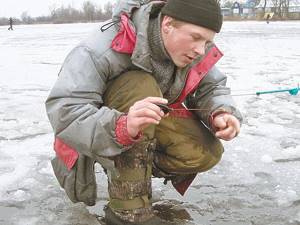
Today, in my bait box there are only five types of jigs and each of them has its own special purpose.
Some are good for fishing in shallows, others are only good for deep water.
There are jigs for first-ice conditions, deep-winter conditions, and for fishing in the current.
And there is a bait that I use only on the last ice and only on shallow grassy reservoirs.
This is a “goat”, and that’s what I want to talk about now.
In the southeast of Belarus, winter always ends approximately the same.
The second half of February, as a rule, is warm, and rivers, as well as large reservoirs, already manage to become free of ice during this time.
Under the ice, only “puddles” remain - rather small floodplain lakes, which in the summer are heavily overgrown with grass.
Sometimes it is so difficult that it is impossible to get fish from here with any gear in the warm season. The maximum depth here does not exceed three meters, but usually a depth of one to one and a half meters is standard. Mostly, the catches from such “puddles” include predatory fish: perch and pike, which feel good here and grow by leaps and bounds.
One of the main components of the diet of local fish are all kinds of insects and their larvae, which live in abundance on underwater vegetation. And if the ice here, safe for human movement, lasts until mid-March, then the winter season can be closed very effectively.
Feeling the influx of fresh water, underwater insects, and after them fish, run aground. The fisherman only needs to be able to present the bait so that it closely resembles a crustacean that has come back from hibernation.
This, it seems to me, is the main secret of the phenomenal catchability of the “goat” - in movement it is very similar to these same crustaceans.
Everything is relative
At first glance, it may seem that the “goat” differs from the “devil” only in the number of hooks. But once you work with this bait, it becomes clear that the main strength of the “goat” is a rather active game of its own, which the “devils” do not have.
Read the material “Mothless is now a red thread”
Strongly resembling the famous “Uralka” or “banana” in body shape, when fishing in grass windows, the “goat” turns out to be much more catchy than these jigs.
Several years ago I was able to take part in an impromptu competition with a fisherman who had spent most of his life fishing on the large lakes of northern Belarus. I fished with a large “goat”, but he remained faithful to the “Uralka”, which, according to him, was the number one bait on his list. In body shape and color, both baits were very similar, but by the middle of the day our catches were very different in both quantity and quality of fish.
“Koza” was the clear leader. However, as soon as my opponent tied a “goat” to the fishing line, his fish-biting situation changed. Small perches and roaches began to appear from the “empty” holes. It would seem that such a small thing as one additional hook can change, but this is a fact.
|
| Photo: Nikolay Linnik. |
Bait equipment options
Most “goats” are traditionally painted in a dark color, but sometimes you come across light and even shiny baits. And yet, dark “goats”, in my opinion, are more catchy.
Read the material “What jigs are needed?”
However, a more important aspect of the catchability of these baits is the presence or absence of weights on the hooks. Having fished with “goats” in various conditions, I came to the conclusion that large perch respond more readily to baits without any decorations, but white fish and “sailors” favor “goats” with additions more.
There is no clear opinion on which color combination to choose. My favorite colors: white, black, yellow and red in various combinations. In my opinion, bead bait always turns out to be a more catchy option than cambrics.
Question of size
I have both small and large “goats” in my arsenal. I dare to assure you that these are completely different baits. And therefore it makes sense to consider each of them separately.
The large “goat” has a pronounced aggressive game. This is perhaps the most specific of all nozzle-free jigs. Attracting fish from a long distance, a large “goat” is somewhat akin to vertical spoons and balancers. I really like to hunt with a large “goat” for perch when it is dispersed over a large area.
Read the material “At the roach with a nod”
The “goat” also has selectivity. Trifles, as a rule, do not favor her. I have been convinced of this more than once or twice.
Last season, in one grassy backwater at a depth of about a meter, I found a school of active perch. But as often happens, I was quickly declassified. After the neighbors made noise with their drills, the large perch hid, but the “sailor fish” bit briskly. After changing a dozen holes, I decided to go all-in and took out a fishing rod equipped with a large “goat”.
To my great joy and the envy of my neighbors, who could not understand anything, a large perch appeared in my holes again. Neither the “devil” nor the “bastard” could compete with my “goat” that day.
The key to success in fishing with any baitless jig is searching for active fish. And since a large “goat” is primarily of interest to a large active predator, you should fish with this bait at the moments when the fish are most active, and it is much easier to look for it.
A little about tactics
In grassy reservoirs, the bulk of the fish stays shallow, so the search for them always starts from the coastal shallows towards the depths. Starting holes are drilled in a checkerboard pattern at a distance of 10-15 meters from each other. I try to drill at least 10 holes at a time in order to cover as many interesting places as possible.
Read the material “Braid round dances: about your spring grouse”
In a shallow water body, this tactic turns out to be the most justified, because while you are drilling the last holes, the fish in the first ones have already calmed down and you can safely catch them.
Drilling the required number of holes with a good drill even in loose March ice is not particularly difficult. Sometimes you have to drill 50 or more holes during one fishing trip.
In each hole I make 5-10 bait runs, and if in any of them there was even the slightest hint of a bite, I fish this place more thoroughly.
|
| Photo: Nikolay Linnik. |
Features of the gear device
It is no secret that a correctly selected nod plays almost the main role in the catchability of any nozzle-less jig. And here a lot depends on the habits of the fisherman.
Some people are used to fishing with lavsan nods, others like boar bristle nods, but I prefer spring nods. Whether it is a combination of metal-lavsan or purely lavsan, there is not much difference.
Read the material “Reflections on fish, lard and the mothless fish”
The spring design is good because it allows you to work equally successfully with bait at different frequencies. When fishing with goats, long nods are much more convenient than short ones. They have a larger range of settings for the weight of the bait.
In total, all these little things are designed to solve one problem - to give the bait an active sweeping game while simultaneously lifting the bait vertically. In practice, it turned out that not everyone succeeds in such a presentation of the jig the first time.
But it is with active and sweeping play that the “goat” shows its best qualities. Of course, the fish can bite even with a calmer game, but in this case the “goat” noticeably loses in performance to a simple jig and its use becomes unjustified.
When fishing for white fish, it is very useful to pause for 2-5 seconds at the end of the retrieve. Often lingerie reacts only to this technique.
A small “goat”, in principle, is no different from a jig with one hook. The fishing rod equipment, playing techniques and wiring options for this bait are the same as, say, a banana or an oatmeal. Small “goats” are more versatile, and therefore I often use them as scouts to find fish, especially if, due to certain conditions, the fish prefer to peck at small baits.
Micro-goats also work well when fishing with a lowering bait. The rudd is especially partial to the descending “goat”. Retrieving the bait in this case is a slow lowering with a slight rocking and long pauses. It is during pauses that most fish bites occur.
Read the material "Jack"
In conclusion, I would like to make one more very important, in my opinion, remark. Still, the “goat” is not a bait for beginners.
Due to its narrow specialization, it (especially large models) is not suitable for all-season bait. But for those who have mastered the intricacies of guiding a “goat,” it is precisely this very narrow specialization that is the main advantage of the “queen of grassy shallows.”
Nikolay Linnik March 18, 2021 at 09:00
Varieties
Goat Pierce drop
These jigs are manufactured industrially from tungsten.
They have a short body and are used without additional elements. The jigs are not painted. Thickened hooks are used, designed for catching large fish. The large specific gravity of jigs allows them to be used for fishing in currents.
Goat bug
Low-frequency lure, also made of tungsten. It is optimal to use “Klopik” on the last ice , when the perch no longer reacts so willingly to jigs that move with high frequency.
“Klopikov” are often equipped with one large bead, which is fixed with a cambric.
Goat banana
The shape of the bait resembles this fruit.
Made from lead and tungsten, it can be used with or without additional decorations. The “banana” goat can be tied in two ways : by the ring at the end of the bait and by the shank of the hook, after passing the fishing line through the eye.
At the same time, the position of the bait in the water changes and, accordingly, its game.
Goat for catching perch
Comes in silver and black. The first option is rarely found on sale, and perch does not react so well to silver. To bring home a rich catch of perch, it is important to choose the right tackle:
- The rod must be strong - a weak one will not allow you to cope with a predatory minke whale.
- The nod is selected with medium elasticity. If it is too soft, the perch will easily come off, but if it is extremely hard, it will not allow you to easily manipulate the jig.
- The fishing line also needs to be strong, but not thick. Otherwise, the fish will not even be able to swim close to the bait.
The perch bite in winter was recorded in February with consistently cloudy weather. Avid anglers say that fish often become active during snowstorms. When it is frosty and the sun is shining, the red-finned minke whale stops pecking altogether or does so sluggishly.
Video on catching perch with a “Koza” in winter
What kind of fish can you catch?
You can catch the following types of fish with a goat jig:
- Perch. Perch is extremely partial to the high-frequency “goat” game. Most often, the striped robber is caught using jigs that are not equipped with either beads or cambric. Sometimes, to make the bait more attractive, a short piece of red woolen thread is tied to the hook.
- Pike perch. Pike perch are caught on large “goats”. It should be taken into account that with baitless jigs it is not recommended to use a fishing line thicker than 0.14 mm and be prepared for the fact that it will not be possible to cope with a large predator.
- Bream. Bream bites on black and red baits with or without additional decoration on the hook. Playing with a jig should be relatively low-frequency.
- Roach. To catch roach, small “goats” are used, which are played at a moderate pace.
You can also catch ide, chub, silver bream and dace with a goat jig.
Making a homemade goat
Given the simplicity of the design, it is not difficult to make a goat with your own hands, following the same principle as when creating jigs from lead. The main difference involves the use of a double hook, and not a single hook, as is the case with a classic jig. In addition, here you can use two single ones, provided that they are the same size.
The plane of the hooks is placed at an angle of 60-90 degrees, and a hole for the fishing line is made above the back side of the jig sphere. When suspended, the goat should occupy a position of 45-60 degrees relative to the horizon, although some anglers hang it vertically.
Modernized versions are equipped with beads, and to make the game more interesting, a rubber strip is attached to one hook, playing an unbalancing role. The bait demonstrates good performance when catching white fish, because in addition to the classic forward horizontal movements, it also rolls to one side.
A weighted goat can be made using lead pellets into which hooks are clamped. Using low-temperature solder, a double or two separate single hooks are soldered into the product, but in such a way that one of them has an eye protruding outward . A knife is used to give shape. Maintaining a smooth surface is not a necessary condition, because it can be faceted, and even untreated from traces of soldering, because all this will be hidden under a layer of varnish.
There are jigs with compact sizes and weight. They are used both alone and in tandem. They are recorded in the presence of small perch or roach in the reservoir.
In some conditions, it is advisable to use a specialized version of the goat, which is made on a flat triangular-shaped substrate. To solder a twist with two hooks on the back side of the foil, POS-90 solder is used. Then the plane is covered with glow-in-the-dark varnish, which can arouse increased interest in the fish . The foil backing is also scraped with a knife to give it extra shine. When it comes to catching roach, the upper part of the bait should have smaller hooks than the lower part. Small black products with a fluorescent spot are effective for catching the following types of fish:
- Roaches.
- Gusters.
- Podleschika.
Tackle
No-bait fishing requires that the gear meet certain requirements.
Fishing rod
The most convenient is the balalaika fishing . The reel should rotate freely, and the handle should be made of “warm” materials: foam or cork.
fishing line
To catch a goat with a jig, a fishing line whose diameter does not exceed 0.14 mm , otherwise the bait cannot be animated as it should. As a rule, monofilament is used, less often fluorocarbon.
Nod
The nod is the most important element of the tackle. With the help of a nod, vibrations of the required frequency are given to the jig. The material used for the nod is lavsan or a clock spring . The nod has a taper. The length of the nod reaches 20 cm. The nod for catching perch must ensure play with the jig with a frequency of at least 300 vibrations per minute; for catching “white” fish, this value is significantly less.
Expert opinion
Knipovich Nikolai Mikhailovich
Zoologist, hydrobiologist. I am interested in fishing at a professional level.
Important! Tackle for fishing with a goat jig should be balanced and versatile. By changing only the length of the nod, you can play with the jig at different frequencies, adapting to the mood of the fish in a particular place at a given moment in time.
Features of equipment installation
Among experienced fishermen, baitless baits are in particular demand and have great potential. Today they are used for fishing on all lakes and rivers , and if we are talking about the famous bait called “goat”, then it has practically no equal of its kind.
In terms of its design features, the product is something between a “devil” and a “uralka”, only the goat has two hooks. When installing gear, you should choose the appropriate color in advance, guided by personal preferences, and not by the habits of the fish. By the way, some fishermen note the particular effectiveness of two-color variations - one hook is equipped with red cambrics, and the other with white ones.
The sizes of goats are compact and quite large. The first option is characterized by particular catchability, and its dimensions are as follows:
- Height - 3−4 mm.
- Width 1.5−2 mm.
With such a fishing tool you can catch not only small prey, but also real trophies, including large roach, large perches and bream . From time to time, the tackle also attracts chub. However, mini-baits are not suitable for greater depths.
When collecting gear, use compact fishing rods with high sensitivity, which, in general, is typical for other areas of winter fishing. There are no high requirements for the material from which the fishing rod is made. The main thing is that it has sufficient rigidity.
The sensitivity of the nod determines the success of the upcoming fight with the fish. It depends on it whether the fish leaves the hook or ends up in the bucket. When playing aggressively, the nod should feel good and not malfunction.
As for the diameter of the fishing line, it should not exceed 0.13 mm . Otherwise, the bait will play very poorly, and fishing will be pointless.
Technique and tactics
The tactics of fishing with baitless jigs are more reminiscent of winter trolling than traditional fishing with jigs and animal bait . Catching predatory fish involves searching for promising places, tracking down schools of perch and pike perch, and fishing several horizons to determine exactly what the fish is currently occupying.
Catching “peaceful” fish is more passive, however, even such fishing will not do without constant movements. Only when a school of roach or bream is found, you can feed the hole and begin leisurely fishing, however, constantly selecting the optimal game with a jig .
Expert opinion
Knipovich Nikolai Mikhailovich
Zoologist, hydrobiologist. I am interested in fishing at a professional level.
Attention! Winter echo sounders are very useful for ice fishing. The movements of the jig and how the fished object reacts to them are clearly visible on the device’s screen. If necessary, you can change the jig or its animation, and if there is no fish, change the place.
The fishing technique for all baitless jigs is fundamentally similar. The bait should be given high-frequency vibrations using a nod. Depending on the type of fish the angler is aiming to catch and its activity, the game with bait should be varied.
Typically, fishing with a baitless jig is carried out as follows:
- Drill a hole and clear it of ice chips;
- lower the jig to the bottom, not forgetting to tap it on the bottom several times;
- begin to lift the jig, playing with it and making short stops;
- at the top point of the wiring, pause for 5-7 seconds;
- lower the jig;
- pause at the bottom of the wiring;
- the cycle is repeated several times.
We should not forget to fish not only the bottom, but also the upper layers of water. The amplitude of the bait play when fishing with a baitless jig is just as important as the frequency. If there are no bites, they move to another hole.
On the river
On the river, the retrieve must be accelerated, since the current does not allow the fish to properly examine the bait. Jigs should be heavier.
On the lake
Fishing on the lake involves using lighter jigs. You can take longer pauses, since a stationary jig cannot be carried away by the current.
If the tackle doesn't work
Very often, fishermen spend a lot of time sitting at the hole, but are forced to return home with bitterness and bad mood, because instead of an active bite they have to endure complete calm. There are also cases that for several minutes the fish actively bites and reacts to the offered bait, but then completely refuses to do so. After catching active fish, you have to change your location, pick up an ice screw and do everything again. But this strategy is only suitable for those who have a few extra hours at their disposal and the desire to work hard.
Other fishermen prefer several areas of the reservoir where they have successfully caught bream or roach over the years. In order not to be disappointed in a proven fishing spot, try to use your entire fishing arsenal, practicing all kinds of retrieves and varieties of jigs. In this case, sooner or later the goat will begin to demonstrate at least some activity, and maybe even give you a trophy catch.
There have been cases where fishermen caught fish for a long time with a “devil”, but then the product stopped working, and they had to change their preferences, choosing a goat. But after some time the goat also became a useless device . However, several active retrieves, which are accompanied by 5-7 oscillations per second, often turned into a way out of the situation, returning the angler to the mood and a good bite.
Homemade jigs
#1 Edgar22
Registration date: 23-February 15
- Send PM
- City: Village Peasant
Hi all! And so now I’ll tell you about my hobby, namely how I make jigs. I spotted some jigs on the Internet, but mostly I figure out how to make them myself. To make these jigs we will need: a thin sheet of copper or brass, hooks, a sewing needle, a wooden board, a soldering iron, solder, soldering acid, sandpaper (zero), a stationery knife, scissors, a set of needle files, pliers. The first type of jig called (banana) is done like this: take a small piece of copper and bend it in half like this, then cut out this shape with scissors, you can make different shapes using this cutting method, after that we bend it and attach it to the board like this, then solder it like this After soldering, we finalize it with a file and polish it with sandpaper. At the exit this is the jig that comes out. The next jig is called something like (clove), I don’t remember exactly. I do it like this: I take a nail and wrap a small piece of copper around it. The output is these forms. Then I take a hook and fix it together with the form like this. Then I solder from the top so that the tin fills the entire form. After that, I finalize the form with a file, grind it with sandpaper and These are the jigs that come out at the exit. To be continued.
- Nik (Uncle Kolya), pensioner, BratAnt and 30 others like this
#2 Edgar22
Registration date: 23-February 15
- City: Village Peasant
Like something from a factory jig after an unsuccessful fishing for a perch, all I had left was its shape. And I decided to restore it. To make this jig, I cut out a triangular shape in a board, put a small piece of copper on this triangle and clamped an old jig there, this is the shape I got, then I made a hole in the mold with a sewing needle and soldered it, then I finished it with a file and sanded it with sandpaper
- Nik (Uncle Kolya), pensioner, NEMO and 29 others like this
#3 Artyom Zakharov
Registration date: 23-Jun 14
- City: Barnaul
The right hobby
Interesting nozzles, carnations are especially good.
Homemade jigs
#1 Edgar22
Registration date: 23-February 15
- City: Village Peasant
Hi all! And so now I’ll tell you about my hobby, namely how I make jigs. I spotted some jigs on the Internet, but mostly I figure out how to make them myself. To make these jigs we will need: a thin sheet of copper or brass, hooks, a sewing needle, a wooden board, a soldering iron, solder, soldering acid, sandpaper (zero), a stationery knife, scissors, a set of needle files, pliers. The first type of jig called (banana) is done like this: take a small piece of copper and bend it in half like this, then cut out this shape with scissors, you can make different shapes using this cutting method, after that we bend it and attach it to the board like this, then solder it like this After soldering, we finalize it with a file and polish it with sandpaper. At the exit this is the jig that comes out. The next jig is called something like (clove), I don’t remember exactly. I do it like this: I take a nail and wrap a small piece of copper around it. The output is these forms. Then I take a hook and fix it together with the form like this. Then I solder from the top so that the tin fills the entire form. After that, I finalize the form with a file, grind it with sandpaper and These are the jigs that come out at the exit. To be continued.
- Nik (Uncle Kolya), pensioner, BratAnt and 30 others like this
#2 Edgar22
Registration date: 23-February 15
- City: Village Peasant
Like something from a factory jig after an unsuccessful fishing for a perch, all I had left was its shape. And I decided to restore it. To make this jig, I cut out a triangular shape in a board, put a small piece of copper on this triangle and clamped an old jig there, this is the shape I got, then I made a hole in the mold with a sewing needle and soldered it, then I finished it with a file and sanded it with sandpaper
- Nik (Uncle Kolya), pensioner, NEMO and 29 others like this
Playing with a jig
This jig can be played in different ways. Sometimes the perch likes it when the angler lowers the goat to the very bottom and begins to lift it half a meter from the bottom in stepwise jerks and lower it back, without pausing. But such a game does not always make the perch bite. In this case, you have to change tactics. You need to lower the spoon to the bottom, also raise it to the same height in stepwise jerks, stop it, after a pause lower it to the bottom in the form of a free fall, then pause again and repeat the manipulations in the same spirit. But if the perch is not good at this, then you can radically change the tactics.
Lower the jig to the bottom, then after a short pause lift it 5 centimeters , make a few nod swings and stop. The pause can last up to 15 seconds . Then raise it again by 5 centimeters , pump and wait. In this rhythm, you can lift it all the way to the ice, because when playing slowly with long pauses, the perch can follow it with its gaze all the way to the ice, and then take off and grab the jig. Most often, perch is caught during the second and third options of the game, and bites occur more often during game stops.
The perch bite in February is not too strong. He gently taps or pulls slightly downward, but he can also nod upward, which happens less often.
Fishing technique
The effectiveness of the goat, just like other baitless baits, depends on the game. The principle of operation is the creation of acoustic waves of a certain frequency and amplitude, to which the fish reacts.
The goat is characterized by a specific game. The game is quite monotonous compared to other jigs, however, this does not make it simple at all.
The game is played quickly and widely with a vertical lift. The game will resemble the movements of the sawing process with a jigsaw. During the retrieve, it is important to change the lifting speed, and at the very end, hold the bait for a couple of seconds. White fish very often bite at this moment.
You should not raise the goat higher than 0.5 m above the bottom.
At first glance, everything is very simple , however, in practice, not everyone can play fast and aggressively. It will take some time to master the game.
It is worth noting that fishing with a goat is often significantly less effective than with another jig. The reason is that the simpler single hook design is much easier to play. Therefore, novice fishermen should still first master other nozzle-less jigs. Preferably at a time when the fish are most active.

